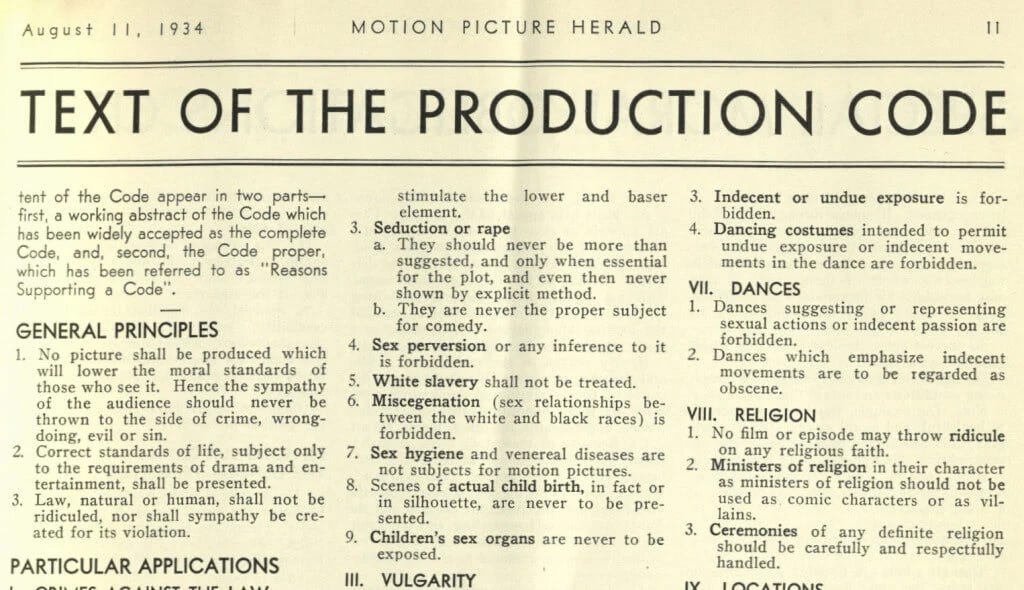The golden age of Hollywood often reminds us of the glitz and glamour that was present in the mid-1930s to the early 1960s, but this was a period in American filmmaking where the 5 major studios, MGM, Paramount, Fox, Warner Bros., and RKO all dominated the production, casting and distribution of major motion pictures. Citizen Kane (1941), Gone with the Wind (1939) and Wizard of Oz (1939) are all considered to be products of the golden age, but they all share one similarity: they were all censored by the Catholic church in one way or the other.
A brief history of the Hays Code.
1. Pre-code Hollywood.
Hollywood during the 1920s was a racy time, full of films about lovers, pirates, and women making their own choices. But the Catholics were quite unhappy about this. They claimed they were witnessing the 'crumbling morality of motion picture films', and this caused a lot of general outrage. Rather than allowing the federal government to regulate films, the five major studios created their own censorship code and appointed Will H. Hays to head this initiative. “The Hays Code was this self-imposed industry set of guidelines for all the motion pictures released between 1934 and 1968,” says O’Brien. “The code prohibited profanity, suggestive nudity, graphic or realistic violence, sexual persuasions and rape. It had rules around the use of crime, costume, dance, religion, national sentiment and morality. And according to the code – even within the limits of pure or realistic love – certain facts have been regarded as outside the limits of safe presentation. So basically, this means we have a whole lot of married couples sleeping in separate beds for at least 20 years.” This raises the question of why major studios would willingly allow themselves to be censored in this manner, but during this time, movies had no first amendment rights, and free speech did not extend to motion pictures.
2. Creation of the Code.
The Motion Picture Producers and Distributors of America (MPPDA) set up its rules of "Don'ts" and "Be Carefuls", many points of which would go on to be official points in the revised code. The list of don'ts consisted of religious profanity (the use of hell or damn), white slavery, sex hygiene, sexual perversion (basically homosexuality), childbirth, and miscegenation (the relation between people of two ethnic groups), to name a few. The "Be Carefuls" were things that were supposed to be dealt with sensitively or avoided entirely. The use of the Flag, sympathy for criminals, sale of women, rape, lustful kissing and deliberate seduction of girls are just a few examples.
Though there were rules around crime, costume, dance, religion, national sentiment and morality, many progressive stories still slipped through the cracks until the mid-1930s. This was when a publisher named Martin Quigly and Daniel Father A. Lord (yes, that was his real name) stepped in and revised the existing code and created the Motion Picture Production Code, which after some revisions, was eventually accepted by The Motion Picture Producers and Distributors of America (MPPDA) because it was better to self-censor than have the government get involved.
3. Enforcement of the Code.
The revised code was mainly divided into General Principles and Particular Applications. The first forbade motion pictures from ridiculing the law and was only allowed to portray the right way of life to not wrongly to influence any susceptible minds who viewed them. No sympathy must be created towards villains or characters who've done wrong. The second part was a more specific list of items that could not be portrayed on screen, like rape, violence, profanity etc.
But this was when the Great Depression hit America, and movie sales tanked. So producers began scrambling to bring in engaging stories, and for a while, between 1930-1934, movies were filled with sex, violence and excessive use of alcohol. The Roman Catholics were quite upset about these occurrences, and studios formed The Production Code Administration (PCA) to enforce the code more strongly and not be boycotted further. This required all films released on or after July 1, 1934, to obtain a certificate of approval before release. A catholic layman Joseph I. Breen was appointed the PCA's head. Under his leadership, which lasted until 1954, the enforcement of the guidelines of the Code was highly rigid.
4. The decline.
The code was followed for over 30 years by all motion pictures produced in the United States. But filmmakers were already finding their way around the code, and only a few took the code as seriously as time went on. In 1939, the word 'damn' was permitted in the movie Gone With the Wind by the Hays Office because of its official use in the novel.
The demise of the Hays code was inevitable because, in 1948, the Supreme Court dismantled the movie studio ownership of movie theatres, allowing more foreign films to enter the industry. In 1952, the Supreme Court overruled its 1915 decision and motion pictures were now included in the first amendment, which removed the legal backing of the Hays Code. Following this miracle decision, in 1968, the Motion Picture Production Code was dismantled. The MPPDA was renamed The Motion Picture Association of America (MPAA), which set up the current rating systems.
References
https://www.masterclass.com/articles/hays-code-explained
https://www.menshealth.com/entertainment/a32290089/hollywood-hays-code/
https://www.studiobinder.com/blog/what-is-the-hays-code-1934/
https://www.acmi.net.au/stories-and-ideas/early-hollywood-and-hays-code/




